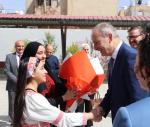You are here
The last pagans of Iraq
Aug 10,2014 - Last updated at Aug 10,2014
With US President Barack Obama belatedly ordering air strikes and humanitarian airdrops of food and relief supplies to refugees in northern Iraq, the world is finally taking action against the Islamic State.
Within a few months, the jihadist group, which until recently called itself the Islamic State of Iraq and the Levant, has taken control of large parts of both countries, where it has proclaimed a new “Caliphate”.
But the real reason to fear the Islamic State is not its lust for power; it is the systematic, cold-blooded way in which its members are erasing the region’s social, cultural and demographic past.
Within a few weeks, the Islamic State has virtually eliminated the entire Shiite Muslim and Christian populations from the lands that it controls.
The city of Mosul, home to one of the world’s oldest Christian communities, no longer has any Christians left. Priceless Assyrian artifacts have been publicly destroyed in a campaign against idolatry.
Indeed, the Islamic State has not even spared Sunni co-religionists who do not adhere to their extreme interpretation of Islam. A number of revered shrines have been demolished, including one said to be the Tomb of Jonah.
As terrible as all of this is, the worst of the persecution has been aimed at the Yezidi, an ancient religious group that lives among the Kurds.
They number less than a half-million, and two-thirds of them live around Mosul in northern Iraq. The rest are scattered across neighbouring countries like Syria, Armenia and Turkey.
More recent immigrant communities are to be found in Germany and the United States.
Although influenced over the centuries by Christianity and Islam, the Yezidi religion has ancient pagan roots that go back at least to the late Bronze Age.
Interestingly, their beliefs have many similarities with Hinduism — for example, they believe in reincarnation, say their prayers facing the sun at sunrise and sunset, and even have a system of castes.
They also worship Tawûsê-Melek, the peacock angel — a bird that is found in the Indian subcontinent but not in Yezidi lands.
While the origins of the Yezidi are uncertain, cultural and genetic evidence suggests that they may be remnants of Indian tribes that migrated West in the second millennium BC.
There is considerable evidence of Indian links with the Middle East during the Bronze Age. For example, Zoroastrianism, the religion of ancient Iran — to which Yezidi religious beliefs have been linked — is closely related to early Hinduism.
Over the centuries, both Christians and Muslims dubbed the Yezidi “devil worshippers” and subjected them to relentless persecution, which was especially extreme under the Ottoman Turks in the 18th and 19th centuries.
A series of massacres killed hundreds of thousands and almost led to their extinction.
Under Saddam Hussein, the Yezidi were not subjected to overt religious persecution, though they remained under pressure to Arabise their culture. Matters have since taken a turn for the worse.
In April 2007, gunmen dragged 23 Yezidi men from a bus and shot them dead. Four months later, a series of coordinated car-bomb attacks killed at least 300 more, including women and children.
The Yezidis now face their greatest crisis ever.
The Islamic State gave the Christians of Mosul the choice to convert, pay the jizya (a special tax levied on non-Muslims under Sharia law), or leave.
The Yezidi have been given no such choice and are killed on sight as “devil worshippers”.
The Yezidi heartland around Mosul is now largely under the Islamic State’s control.
The small town of Sinjar, the only place in the world with a Yezidi majority, fell in the first few days of August as Kurdish fighters were forced to withdraw.
Reports of large-scale massacres are trickling in. Many refugees escaped into the mountains, where they are trapped in shrinking enclaves.
Hundreds are said to have died already of thirst and starvation.
The most sacred Yezidi pilgrimage site at Lalish runs the risk of being demolished.
Sadly, there has been little media outrage at the predicament faced by the Yezidi.
Perhaps the US airdrops and promised strategic interventions, together with a possible coordinated operation by Kurdish forces (rearmed by the US), may rescue the survivors, but it appears unlikely that they will be able to return to their homes soon.
Centuries ago, the last Zoroastrians fled persecution in Iran for India. Their descendants, the tiny Parsi community, still live there. Today, who will give refuge to the last pagans of Iraq?
The writer is an economist and the author of “The Indian Renaissance” and “The Land of the Seven Rivers”. He was named a Young Global Leader in 2010 by the World Economic Forum. ©Project Syndicate, 2014. www.project-syndicate.org











